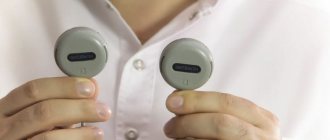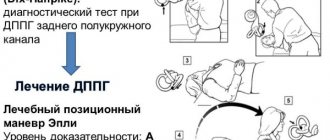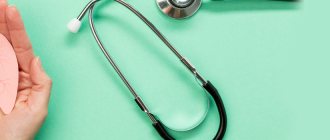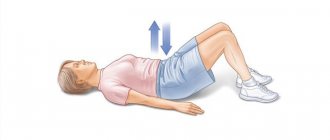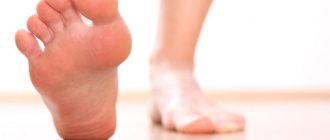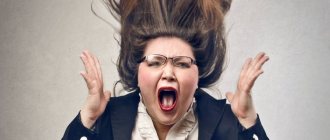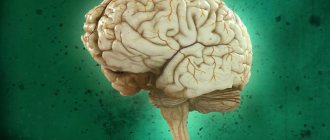The vestibular apparatus is an organ of balance. Together with the visual and motor receptor systems (a receptor is an anatomical formation that converts perceived irritation into nerve impulses), it plays a leading role in a person’s orientation in space. The vestibular apparatus perceives information about acceleration or deceleration that occurs during any type of movement, as well as when the position of the head changes in space. The sense of gravity is also analyzed here, which is why the vestibular apparatus is also called the organ of gravity. Under resting conditions, the receptors of the vestibular apparatus are not excited. Irritation of the receptors occurs when the head is tilted or moved. In this case, reflex muscle contractions occur, helping to straighten the body and maintain balance.
General information
Vestibulopathy is a disorder of the normal functioning of the vestibular apparatus , in which characteristic symptoms appear.
The ICD-10 code for vestibulopathy is H81 (Vestibular function disorders). The normal orientation of a person in space and his balance in a vertical position is ensured by the vestibular apparatus. Disturbances in its work lead to a person experiencing confusion, dizziness , and the inability to remain in a standing position. This condition is also called labyrinthopathy. It can develop due to various reasons and diseases, developing at any age in every person. Sometimes vestibulopathy is a congenital pathology.
It may manifest itself as a separate syndrome or as a sign of neuropsychiatric disorders. In the second case, it is more difficult to treat this disease. How this pathology manifests itself, and what treatment methods are advisable to practice, will be discussed in this article.
Etiology
Factors provoking the development of the syndrome:
- Anxiety and restlessness
- Prolonged grief and sorrow
- Stress and nervousness,
- Psycho-emotional exhaustion and physical stress,
- Poor nutrition, starvation, exhausting diets,
- Elderly age.
Diseases manifested by vestibular disorders include pathologies of the labyrinth, brain, spine, nervous system, traumatic head injuries, neoplasms, acute infections, as well as age-related characteristics.
- TBI with loss of balance due to sudden movement of the head.
- Labyrinthitis is an inflammation of the inner ear of infectious etiology, manifested by dizziness and cochlear disorders.
- Infarction of the labyrinth in elderly people and in young people against the background of atherosclerosis or increased blood clotting, manifested by uncertainty in determining one’s position in space, ataxia, neurological signs, and incoordination of movements.
- Meniere's disease with paroxysmal dizziness, ear congestion, dyspeptic symptoms, sensorineural hearing loss.
- Basilar migraine – dizziness, acute headache, loss of stability, hypersensitivity to loud sounds and bright light.
- Multiple sclerosis is manifested by staggering while walking, ataxia, tremor, horizontal nystagmus, debilitating headache, deafness, paresthesia, and emotional lability.
- Vestibular neuritis caused by the herpes virus worsens in the fall or spring and is manifested by dizziness and dyspeptic symptoms. Symptoms of the disease last for several days and gradually regress.
Rarer causes of the syndrome include:
- acute inflammation of the middle ear,
- vertebrobasilar arterial system syndrome,
- cardiopsychoneurosis,
- degenerative-dystrophic lesions of intervertebral discs in the cervical spine,
- arterial hypertension,
- neoplasms and cysts in the brain,
- psychogenic disorders,
- acute conditions after ear surgery.
Weakness in the legs and loss of balance can also be caused by ordinary motion sickness in transport or drug poisoning. Idiopathic vestibular syndrome has no known cause. Its origin is not related to other conditions or diseases of the patient.
Pathogenesis
Vestibular insufficiency can occur at any age. Sometimes this is a congenital pathology. The pathological process is localized in the inner ear. The vestibular apparatus, which is a complex receptor of the vestibular analyzer, consists of three arches. They are located at an angle of 90 degrees to each other. They contain liquid, which is distributed through the channels depending on the position of the human body, gravity, the force of attraction, as well as the influence of a number of other factors. The brain receives impulses that determine the movements of different parts of the body. Vestibular insufficiency develops when the functioning of the vestibular apparatus is impaired.
Vestibulopathy can develop with a variety of pathogenetic variants of damage to the peripheral or central part of the vestibular analyzer, which performs three important functions - maintaining balance, spatial orientation, and image stabilization.
Features of the disease
Vestibular vertigo is characterized by patients as a sensation of swaying, rotating, falling of the surrounding space, objects, as well as one’s own body. The cause of this disorder is a malfunction of the vestibular analyzer.
This disorder is systemic in nature; it disorganizes the work of many important systems in the body: vestibular, visual, muscular.
Systemic and non-systemic dizziness associated with dysfunction of the vestibular analyzer can occur for various reasons. Thus, central dizziness is caused by malfunctions of the brain, peripheral dizziness is caused by disruption of the middle ear or nerve, and the cause of physiological dizziness is ordinary fatigue, overwork, severe stress or prolonged malnutrition.
The causes of vestibular episodic systemic vertigo can be a variety of lesions in the central and peripheral parts. If the attacks are constant, the reason for their occurrence may be:
- infectious and traumatic damage to vestibular fibers;
- use of drugs that have a toxic effect on the receptors of the vestibular apparatus.
Classification
Depending on the nature of its origin, vestibulopathy is divided into several types:
- Vertebrogenic – develops against the background of pathologies of the cervical spine. It can be observed with osteochondrosis , osteoporosis , intervertebral hernia , etc. This form is the most common. This condition is characterized by prolonged dizziness and a feeling of head instability. When trying to focus your gaze on moving objects, discomfort occurs. Spontaneous attacks of eye rotation may occur when a person tries to turn his head sharply. They last no longer than 30 seconds.
- Peripheral - develops as a consequence of the inflammatory process in the nerve ganglia in the inner ear. Most often this occurs due to allergies or infections. With such a lesion, in addition to vestibular disorders, the patient may experience tinnitus and causeless fear. Prolonged dizziness and bouts of eye rolling are noted.
- Central - develops if disturbances occur in the function and structure of the vestibular nuclei of the medulla oblongata and cortex.
- Post-traumatic – develops after traumatic brain injury if hemorrhage occurs in the labyrinth of the inner ear. As a result, tissue damage is noted. The eardrums may also be damaged, and the ganglia of the brain may be shaken and damaged. In this case, both dizziness and other characteristic signs are noted - spontaneous eye movements, nausea, vomiting. In addition, a patient with such a lesion has an unstable gait - it is difficult for him to stand on his feet.
Cochleovestibular syndrome is also distinguished . In this condition, auditory and vestibular function is impaired. Cochleovestibular disorders are accompanied by tinnitus, hearing loss, dizziness, and imbalance.
How does the balance organ work?
Although the vestibular system is located inside the bone box, this does not prevent it from collecting information not only about the position of the head, but also the arms, legs and other organs of the human body. The connection with the balance apparatus is especially secure at the nerve endings, gastrointestinal tract, and cardiovascular system. That is why, after being nervous and drinking too much coffee, many people feel dizzy.
Under the influence of attraction, the jelly-like liquid and the crystals in it will shift, affecting the balance receptors. The villi will immediately transmit information to the brain about changes in balance, and from there instructions will come to other organs: change muscle tone, move your leg or arm to the right, stand up straighter. It is very interesting that the vestibular system is configured only for horizontal movement of the body, so when going up in an elevator or flying on an airplane, many experience severe nausea, ringing in the ears, and dizziness.
- Treating depression without drugs
- Fitness at home - video with exercises for weight loss. Home fitness video tutorials
- Gravy for cutlets: delicious recipes
Functions
In close proximity to the optic nerves and auricles, the balance system has nothing to do with either hearing or vision. The main function of the vestibular apparatus is to analyze changes in the position of the arms, legs, torso or head and transmit data to the brain. The organ quickly reacts to minimal external influence, detecting even the slightest changes in the gravitational field of the planet, helping to maintain balance in complete blindness or navigate in unfamiliar space.
Causes of vestibular apparatus disorders
The causes of dysfunction of the vestibular apparatus can be very different. Basically, vestibulopathy is provoked by the following factors:
- Cervical osteochondrosis - due to displacement of discs and vertebrae, the functioning of the vertebral artery is disrupted, which impairs blood supply. In addition, with osteochondrosis, the nerves are pinched, which also leads to dysfunction of the vestibular apparatus. Also, problems with the vestibular apparatus can be observed with intervertebral hernia, osteoporosis, etc.
- Pathologies of the inner ear - this may be a violation of lymph flow in the middle ear, inflammatory processes, otitis media, etc.
- Labyrinthitis is an inflammatory disease that provokes the development of periodic dizziness.
- Meniere's disease - during the development of the disease, pathological changes in the inner ear are noted.
- Infarction of the labyrinth – leads to impairment of hearing and function of the vestibular apparatus.
- Vestibular neuronitis is a consequence of herpetic damage to nerve fibers. If a person is diagnosed with vestibular neuronitis, it should be taken into account that signs of the disease appear periodically - during exacerbation. As a rule, this happens in spring and autumn. Also, vestibular neuritis can develop as a consequence of acute respiratory infections, influenza , etc.
- Migraine - with this disease, the symptoms are similar to vestibulopathy, but the hearing does not change.
- Diseases of the central nervous system - can cause pathological processes in the membranous labyrinth.
- Traumatic damage to the thin bone membranes of the labyrinth , in which the eardrum ruptures or hemorrhage in the middle ear - this can happen with severe coughing, straining, diving.
- Vertebrobasilar insufficiency - manifests itself mainly in older people, causing damage to the vestibular analyzers. With this pathology, the blood vessels, cerebellum and brain stems are affected. The duration of such an attack is several minutes, during which the person loses balance and orientation in space, he develops weakness, and his limbs go numb.
- Intoxication of the body due to taking certain medications.
- Neurotic disorders.
- Neuromas are tumors that form and grow from nerve cells.
- Occupational diseases – working in conditions of constant vibration or noise.
FIGHTING SEA SICKNESS
Often, while on a trip, we experience symptoms of motion sickness: dizziness, nausea, headache, lack of appetite.
What is motion sickness and what is its cause? Motion sickness in transport
is the same as the so-called seasickness (in medical language - kinetosis, motion sickness).
Kinetosis was called “sea sickness” because people first encountered this phenomenon while traveling on water. Kinetosis occurs when we are exposed to monotonous vibrations - in a car, train, plane, boat, swing or merry-go-round. The cause of seasickness
is a malfunction of the vestibular apparatus, which is responsible for keeping us firmly on our feet.
It responds to changes in the position of the head and body in space, as well as to acceleration. When a person's body moves and sways in a car or on a ship, the brain receives conflicting information from different senses. Receptors in the vestibular system say that the body is motionless, but the eyes see that everything around is moving and swaying. This failure leads to dizziness and nausea. Most people have a vestibular system that is trained enough to easily tolerate these disruptions. People who get motion sickness in transport apparently have some genetic characteristics that cause the vestibular apparatus to fail to cope. Although there may also be provoking external factors: heat, stuffiness, the smell of tobacco, alcohol consumption, overwork, emotional stress, pregnancy. In children, the cause of kinetosis is often insufficient maturity of the hearing organ, where the vestibular apparatus is located, and the autonomic part of the nervous system. As you grow older, these phenomena disappear. To “trick” the bular apparatus, you can move your feet or shift from heel to toe. This will reduce the discrepancy between signals from different senses to the brain: the vestibular apparatus will think that you are walking on the ground. TRAINING THE VESTIBULAR APPARATUS: Stand next to a closet or at the back of a chair and make 1 turn clockwise. You can make one more turn to avoid falling. Turn around in the opposite direction counterclockwise 2 times. Do the exercise again, 2 turns in both directions. The next day, increase the number of turns by 1 in each direction, etc. “Planet Health”
talks with Doctor of Medical Sciences Irina Nikolaevna Kholodova, professor of the Department of Pediatrics with a course of outpatient pediatrics named after. G. N. Speransky RMANPO.
— Irina Nikolaevna, is motion sickness a disease?
- This is not a disease, but a symptom. But it may be a signal of some problems or diseases in the body that require mandatory clarification. This is often the result of inflammation of the ear, ailments of the autonomic nervous system, gastrointestinal tract, and tumors in the brain. If motion sickness is caused by a disease, it cannot be cured without treating the underlying disease. Nevertheless, motion sickness can be an individual physiological feature in completely healthy people. This greatly complicates a person’s daily life, since even an ordinary trip on public transport turns into a problem for him. And long trips become completely impossible. But motion sickness can be treated if you take this problem seriously and thoughtfully.
—Who usually gets seasick?
— The prevalence of motion sickness is extremely high. Studies have shown that motion sickness occurs in more than 60% of cases in children under 10 years of age. At the age of 10 to 20 years, motion sickness is noted by 45% of respondents. On average, 5–10% of people suffer from systematic motion sickness. Older people are much less likely to complain of motion sickness.
— How does motion sickness manifest itself in adults and children? Is there a difference in symptoms?
— Manifestations of kinetosis are the same in both children and adults: a feeling of nausea, vomiting, cold sweat, severe dizziness, a feeling of lack of air, panic. The only difference is in the causes of its occurrence - in children it is associated primarily with imperfections of the vestibular apparatus and nervous system. Childhood motion sickness most often goes away after adolescence. In adults, it is often not possible to find out the cause of kinetosis. It is believed that it may be caused by genetic characteristics, heredity, a sharp change in position in space, emotional stress, and impaired blood flow.
— What recommendations can you give before the trip?
— If possible, choose night trips. “Motion sickness” is due to the fact that visual signals and the sense of the body’s position in space do not coincide. A difficult journey can go better in the dark. You can try thick sleep glasses. In order to make your life easier, you need to follow simple recommendations. Firstly, two hours before travel it is better not to eat, drink alcohol or carbonated drinks. Secondly, on board the transport you need to be distracted and have fun, even if just to talk with a fellow traveler. In addition, you need to choose the right location. On a sea vessel these are cabins in the middle of the ship, closer to the waterline; on an airplane - seats close to the wings; in a car or bus - the front seats. In any transport, you should avoid seats located in the direction opposite to traffic. If we are talking about traveling on a ship, it is better to be at the stern and look not at the waves, but at the horizon line, which is motionless. In a car, it is optimal to sit in a seat next to the driver and keep an eye on the road. To avoid severe motion sickness, you should not read while in a moving vehicle.
— What to do if the disease takes you by surprise?
- If seasickness takes you by surprise, you need to let the patient swallow small pieces of ice and drink acidified water. Many people find that cold on the face, neck and a warm heating pad on their feet help. Another remedy is to establish deep rhythmic breathing (8-10 times per minute). A radical remedy for seasickness is to stop traffic and not use this type of transport in the future. Of course, if a person becomes ill in an elevator, there is no problem - climbing to the desired floor on your own is only good for your health.
- But what if you get motion sickness everywhere?
- In this case, training the vestibular apparatus will help. You can start riding on swings and rides. Balance exercises are very effective - for example, when you need to hold your body weight alternately on one leg and the other with your eyes closed, rotate your body and head in different planes, or exercise on a large gymnastic ball. Acrobatics, swimming, gymnastics, dancing, somersaults, trampolining, swimming, diving, skating and roller skating will also help strengthen the vestibular system. In the morning, you can do special gymnastics, with bending the torso and head, turns, somersaults, jumps, and various exercises on the horizontal bar. Start with a few repetitions, gradually increasing their number. Looking at the gadget, you can feel nauseous, even if you usually don’t get motion sickness in transport? — While in motion, for example, in a car, a person feels through the vestibular apparatus that he is moving with a certain acceleration and in a certain direction, but at the same time, the receptors of his muscles, bones and joints send information about his complete immobility. Such a contradiction between two streams of information irritates the centers that control balance and body position in space, which in turn causes dizziness, nausea and vomiting. And if at the same time a person is also looking at the gadget, his eye reacts to movements up, down, and to the side. As a result, random signals begin to enter the brain, which enhance kinetosis.
— What medications can be used to prevent and treat motion sickness?
— If the recommendations do not help, you can use drug therapy. The most promising is the use of natural preparations based on products of natural origin. They have proven effectiveness in practice, are safe, especially for children, and help get rid of the main symptoms of motion sickness without side effects or sedation. As a drug that satisfies all these requirements, the complex drug “Cocculin” can be recommended, which has been successfully used in France since 1969. It contains components that can eliminate all the symptoms of motion sickness described above. The peculiarity of “Cocculin” is that it can be prescribed to both adults and children, has an effect proven in clinical trials, and also has no side or toxic effects.
— What is the regimen for taking the drug “Cocculin”?
— The dosage regimen is simple: prevention — 2 tablets 3 times a day the day before and on the day of the trip; treatment - 2 tablets every hour until the condition improves.
The tablets should be slowly dissolved 20–30 minutes before meals or 1 hour after meals. The accumulated experience in the use of Cocculin allows us to recommend the drug for the treatment of children from 3 years of age and adults with symptoms of motion sickness in transport.
Symptoms of vestibulopathy
The basis of vestibulopathy are four main symptoms:
- systemic dizziness;
- vegetative manifestations - nausea, vomiting, hyperhidrosis , heart rate disturbances, etc.;
- imbalance;
- spontaneous nystagmus .
However, disorders of the vestibular system can manifest themselves differently in different diseases. Therefore, it is important to pay attention to the following manifestations:
- I feel dizzy from time to time, and this symptom occurs quite often.
- Difficulties appear in maintaining balance - it seems that the body “does not obey” while walking or trying to move.
- Vision deteriorates, spots and goosebumps appear in the eyes.
- of migraines increases .
- Hearing deteriorates, tinnitus bothers me.
- Nystagmus is periodically observed - the movement of the eyeballs in one direction.
- Periodic nausea and vomiting.
If a person does not know what vestibular neuritis and how it manifests itself, then he can ignore the symptoms of vestibular neuritis for a long time, believing that these are just signs of overwork.
Bibliography
- "Biological encyclopedic dictionary." Ch. ed. M. S. Gilyarov; Editorial team: A. A. Babaev, G. G. Vinberg, G. A. Zavarzin and others - 2nd ed., corrected. - M.: Sov. Encyclopedia, 1986.
- "Otorhinolaryngology". Textbook ed. I.B. Soldatov and V.R. Hoffman. – St. Petersburg, 2000. – p.41-45, p.75-96.
- Soldatov I.B. "Lectures on otorhinolaryngology: Textbook." – M.: Medicine, 1994. – pp. 40-56., pp. 261-277.
- How the vestibular apparatus works - https://theoryandpractice.ru (Access date: 07/01/2019)
- How to train the vestibular apparatus at home - www.sovsport.ru (Date of access: 07/02/2019)
Tests and diagnostics
To establish a diagnosis, the patient must see a doctor, who first conducts a detailed survey and examination. Further, if necessary, further studies will be prescribed.
The study of the vestibular apparatus can be carried out using different methods. There are three main tests to check how the vestibular apparatus works: rotational , thermal and mechanical . In addition, you can undergo simple testing to determine the presence of coordination disorders.
With the help of such tests, a study of the functions of the vestibular apparatus for VVC in Moscow (Khimki, etc.) and other cities is carried out.
- Rotation test - to conduct it, a person sits in a chair and tilts his head forward. After this, 10 rotations are carried out over 20 seconds, then the chair suddenly stops. After this, nystagmus develops. Having measured its duration, the procedure is repeated again with rotation in the opposite direction. Normally, nystagmus will last the same amount of time - 20-50 seconds. If the difference between the two results is 25%, then we can talk about balance disorders.
- Mechanical examination - for this purpose, a rubber bulb is used, with the help of which the external auditory canal is filled with oil to displace the air from it. Next, the pear is compressed and unclenched, checking for damage to the bone capsule of the labyrinth.
- Thermal examination - the patient's ear canals are washed with water for 30 seconds.
At this time, nystagmus occurs, and assessing its duration makes it possible to determine the sensitivity of the vestibular apparatus.
Tests are carried out to determine coordination. This could be walking in a straight line with your eyes closed, trying to touch the tip of your nose with your eyes open and closed, etc.
There are other tests to determine whether the vestibular apparatus is weak or strong.
- Nystagmus can be measured using so-called Frenzel glasses . These are special magnifying glasses with bulbs equipped with light bulbs that illuminate the eyes.
- Also for this purpose, the method of electronystagmography - measuring nystagmus using electrodes.
- A neurological examination is also carried out, aimed at determining the condition of the nerve trunks of the eyeball and the muscles of the facial skull.
- MRI allows you to determine the condition of the spine.
- The inner ear and eardrum are also examined.
Other studies may be prescribed. The doctor will tell you during the consultation where to undergo such a study and what the conclusion looks like.
Autonomic reactions
Through a set of nerve structures located in the central parts of the brain stem (medulla oblongata and midbrain, visual thalamus), the cardiovascular system, gastrointestinal tract and other organs are involved in vestibular reactions. With strong and prolonged stress on the vestibular apparatus, autonomic reactions occur in the form of a slowing pulse, decreased blood pressure, dizziness, nausea, vomiting, cold hands and feet, pale face, cold sweat, etc. Similar symptoms are possible with seasickness or going up in a high-speed elevator. This is due to the fact that a person is accustomed to movements in the horizontal plane, but movements up and down or to the sides are unusual for him. Special training (swings, rotation) and the use of medications reduce the excitability of the balance organ and prevent undesirable effects.
Treatment with folk remedies
Some folk remedies can be used as auxiliary methods during the period of treatment and recovery for vestibulopathy.
- Melissa tea . 1 tbsp. l. Dried lemon balm pour 1 cup boiling water. After 10 minutes, drink with honey. It is recommended to drink this tea for dizziness twice a day.
- Infusion of parsley seeds . Finely grind parsley seeds, 1 tsp. pour the raw material into 1 glass of water and leave for 8 hours. Drink 50 ml 4 times a day.
- Infusion of nettle leaves . 1 tbsp. l. Pour dry nettle leaves into a thermos and pour 200 ml of boiling water. After two hours, strain by squeezing out the nettle leaves. Combine the resulting liquid with the same amount of fresh apple juice. Drink throughout the day. Take for two weeks.
- Essential oils . Mix 50 ml of camphor oil with 25 ml of fir oil and 10 ml of juniper. Mix thoroughly and lubricate the lymph nodes on the neck, nose and mouth with the resulting product. Please note that this product should not be applied to open wounds.
- Infusion of mistletoe and Japanese Sophora . The dry raw materials of both plants need to be crushed and mixed with 15 g of each component. Pour 500 ml of boiling water. When the product is infused, drink 100 ml before meals.
Treatment of the disease
Under no circumstances should you start treating problems with spatial orientation and dizziness that were caused by injuries or neurological diseases on your own. You need to contact specialists as soon as possible.
Drug treatment
Medicines are used to get rid of short-term disorders of the vestibular system. Among the most effective are the following:
- Nootropics. They are working on activating metabolic processes in the brain. Actovegin, Vinpocetine, Phenibut, Phenotropil, Phezam, Cinnarizine.
- Histaminomimetics. Among this group of drugs, Vestibo has proven itself to be the most effective. After taking it, impulse transmission improves, signs of nausea are eliminated and cerebral circulation is stabilized.
- Neuroleptics. For prolonged attacks of vomiting and constant nausea, drugs of this group are used, which include: Motilium, Mosid, Domidon.
- Benzodiazepines. Drugs that have a sedative effect and at the same time help against dizziness: Relium, Diazepam, Sibazon.
- Antihistamines. Helps eliminate allergic reactions: Meclozine, Diphenhydramine, Promethazine, Fexofenadine.
- Anticholinergics. Prescribed for vascular disorders: Atropine, Metacin, Buscopan.
The choice of certain medications depends entirely on the reasons that caused problems with VA.
Treatment at home
Home treatment can only be done if functional disorders of a temporary nature occur. In case of problems caused by serious pathologies, therapy must be discussed with your doctor.
Homemade recipes can help against periodic signs of nausea and frequent dizziness:
- Propolis tincture. Dissolve a tablespoon of propolis in water and pour into 500 ml of vodka, then leave in the refrigerator for 4 days. Next add honey to taste. Take 1 teaspoon three times a day, 40 minutes after meals,
- Clover tincture. Place 3 tablespoons of dry heads in 500 ml of vodka, then leave in a dark place at room temperature for a week, shaking occasionally. Take according to the same scheme as in the previous case,
- Parsley tincture. Helps with dizziness. You need to put 2 tablespoons of seeds in 250 ml of cold water and keep for 7 hours. Take a few sips as needed
- Complex infusion. For it you need to take equal parts of ground pumpkin seeds, chamomile inflorescences, dry orange peels, mint and fennel. Next, infuse in the ratio of 1 tablespoon of the mixture to 250 ml of boiling water and strain. Use before bedtime
- Mint-ginger tea. Take equal quantities of grated ginger root and mint leaves. Brew and drink half a glass every morning half an hour before breakfast and 60 minutes before bed.
From the editor: How to quickly relieve a headache
Among other things, during dizziness and attacks of nausea, you can start rolling walnuts in your palms. This will allow you to take your mind off what is happening and stop the attacks.
Gymnastics for training
It is immediately worth noting that the complex of physical therapy is selected individually, based on the type of vestibular disorders. For nystagmus, oculomotor gymnastics are recommended:
- Rotating the eyeballs.
- Movement of the eyes in different directions.
- Change in gaze range. To do this, you first need to fix your gaze on some object near your face, and then gradually move it away to a distance of up to 60 cm.
To normalize balance, you must perform the following exercises:
- head rotations and tilts at variable tempos,
- the above eye exercises,
- raising and lowering the shoulders
- tilting the body with the object,
- throwing a ball from one hand to another.
All exercises must be performed for at least 15 minutes.
Prevention
The following prevention methods should be practiced:
- Limit situations that provoke an attack of vestibulopathy.
- Eat right, avoiding lack of vitamins and minerals. If necessary, take vitamin-mineral complexes periodically.
- Get proper rest, sleep at least 7 hours a day.
- To refuse from bad habits.
- Exercise daily, do yoga, Pilates, swimming.
- Treat bacterial and viral diseases in a timely manner.
- If vestibulopathy occurs, consult a doctor.
Diet
Salt-free diet
- Efficiency: 5-10 kg in 13 days
- Time frame: 13 days
- Cost of products: 4500-8000 rubles for 13 days
For some diseases that provoke vestibulopathy, it is recommended to adhere to a salt-free diet or limit the amount of salt in the menu.
In general, nutrition should be rational and varied, and the diet must include fresh fruits and vegetables, meat, fish, dairy products, nuts, and vegetable oils.
You should give up alcohol.
Consequences and complications
A severe complication of vestibulopathy can be purulent labyrinthitis , which, in turn, sometimes develops into meningitis . Therefore, inflammation in the inner ear must be treated under the close supervision of a doctor.
Vestibulopathy, moreover, negatively affects the overall quality of life. Dizziness and migraines impair work ability. In addition, such manifestations can cause accidents and traffic accidents.
In advanced stages, the auditory nerve may be affected, leading to the development of hearing loss.
This condition can also lead to cognitive impairment.
Where is the organ of balance located?
If you open an anatomy textbook, you can see many photos of the structure of the balance system. However, most of these images do not provide a clear idea of where the vestibular apparatus is located in humans. If you imagine the structure of the skull from the inside, you will find that this organ is located in the inner ear. Around the balance apparatus are the semicircular canals, jelly-like endolymph and receptors of the vestibular analyzer.
Although the vestibular system is located inside the bone box, this does not prevent it from collecting information not only about the position of the head, but also the arms, legs and other organs of the human body. The connection with the balance apparatus is especially secure at the nerve endings, gastrointestinal tract, and cardiovascular system. That is why, after being nervous and drinking too much coffee, many people feel dizzy.
Under the influence of attraction, the jelly-like liquid and the crystals in it will shift, affecting the balance receptors. The villi will immediately transmit information to the brain about changes in balance, and from there instructions will come to other organs: change muscle tone, move your leg or arm to the right, stand up straighter.
List of sources
- Zamergrad M.V., Grachev S.P., Gergova A.A. Acute vestibular vertigo in old age: stroke or peripheral vestibulopathy. Journal of Neurology and Psychiatry. S.S. Korsakov. Special issues. 2018; 118(6-2): 46-49.
- Parfenov V.A., Abdulina O.V., Zamergrad M.V. Differential diagnosis and treatment of vestibular vertigo // Neurology, neuropsychiatry, psychosomatics. - 2010. - No. 2. - P. 49-54.
- Suslina Z.A., Varakin Yu.Ya., Vereshchagin N.V. Vascular diseases of the brain. M. 2006.
Sources
- Wu X., Liu M., Zhuang HW., Chen KT., Yang ZY., Xiong GX. [Cochleo-vestibular lesions and prognosis in patients with profound sudden sensorineural hearing loss: a comparative analysis]. // Zhonghua Er Bi Yan Hou Tou Jing Wai Ke Za Zhi - 2021 - Vol55 - N5 - p.472-478; PMID:32842361
- Rawlins KW., Zhan KY., Mattingly JK., Feldman AZ., Adunka OF. Fibrous dysplasia mimicking a pediatric endolymphatic sac tumor. // Int J Pediatr Otorhinolaryngol - 2021 - Vol129 - NNULL - p.109785; PMID:31770666
- Rajeshwari B., Shanmugam S., Sadiya N., Mitra G., Chendilnathan B. “Endolymphatic sac tumor”: A case report with review of literature. // Indian J Pathol Microbiol - 2021 - Vol62 - N4 - p.608-610; PMID:31611452
- Eguchi S., Hirose G., Miaki M. Vestibular symptoms in acute hemispheric strokes. // J Neurol - 2021 - Vol266 - N8 - p.1852-1858; PMID:31037419
- Lee JY., Kim CH., Park JS., Kim MB. Peripheral Vestibulopathy Presenting as Acute Vertigo and Spontaneous Nystagmus with Negative Video Head Impulse Test. // Otolaryngol Head Neck Surg - 2021 - Vol160 - N5 - p.894-901; PMID:30665325
- Strupp M., Mandalà M., López-Escámez JA. Peripheral vestibular disorders: an update. // Curr Opin Neurol - 2021 - Vol32 - N1 - p.165-173; PMID:30562267
- Wang HW., Guo Y., Zhou J., Zhou HF. . // Lin Chung Er Bi Yan Hou Tou Jing Wai Ke Za Zhi - 2021 - Vol32 - N2 - p.99-102; PMID:29757553
- Sonoda S., Yoshimura M., Abe C., Morita H., Ueno H., Motojima Y., Saito R., Maruyama T., Hashimoto H., Tanaka Y., Ueta Y. Effects of hypergravity on the gene expression of the hypothalamic feeding-related neuropeptides in mice via vestibular inputs. // Peptides - 2021 - Vol105 - NNULL - p.14-20; PMID:29751050
- Park JS., Kim CH., Kim MB. Comparison of Video Head Impulse Test in the Posterior Semicircular Canal Plane and Cervical Vestibular Evoked Myogenic Potential in Patients With Vestibular Neuroitis. // Otol Neurotol - 2021 - Vol39 - N4 - p.e263-e268; PMID:29494469
- Tamás LT., Lundberg YW., Büki B. Vergence increases the gain of the human angular vestibulo-ocular reflex during peripheral hyposensitivity identified by cold thermal irrigation. // J Vestib Res - 2021 - Vol27 - N5-6 - p.265-270; PMID:29400687
